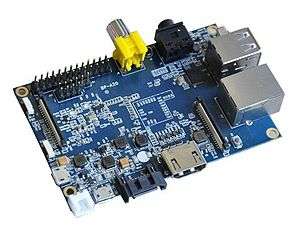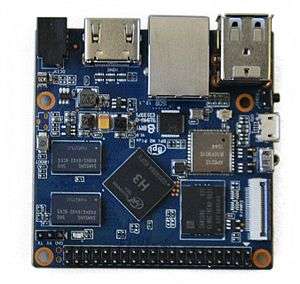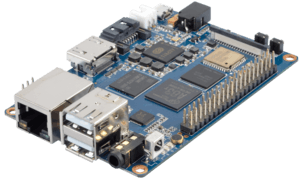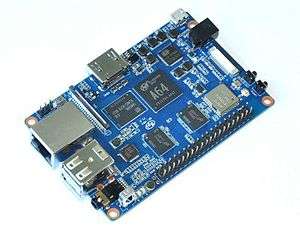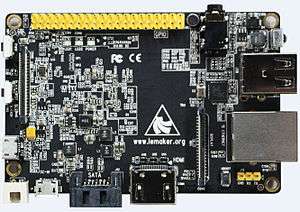Banana Pi
The Banana Pi is a series of credit card-sized single-board computers based on a low cost concept for inner software and hardware development and school software learning such as Scratch. Its hardware design was influenced by Raspberry Pi in 2013. It is produced by the Chinese company Shenzhen SINOVOIP Co.,Ltd.
Banana Pi software is compatible with Raspberry Pi boards. Banana Pi also can run NetBSD, Android, Ubuntu, Debian, Arch Linux, Raspbian operating systems, though the CPU complies with the requirements of the Debian armhf port.[1] It uses the Allwinner SoC (system on chip) and as such is mostly covered by the linux-sunxi port.
Banana Pi is the open source hardware and software platform which is designed to assist bananapi.org and banana-pi.org.
Banana Pi M1
|
Banana Pi single board computer | |
| Developer | Banana Pi |
|---|---|
| Type | Single-board computer |
| Release date | Apr 2014 |
| Operating system | Android (Android 4.2, Android 4.4),Linux (Armbian, Bananian, Lubuntu, Raspbian, Debian GNU/Linux, Fedora, Arch Linux ARM, Gentoo, openSUSE), Berryboot, FreeBSD, OpenWrt |
| System-on-chip used | Allwinner A20[2] |
| CPU | ARM Cortex-A7 Dual-core (ARMv7-A) 1 GHz |
| Memory | 1 GB |
| Storage | SD card & SATA 2.0 |
| Graphics | Mali-400 MP2[3] |
| Dimensions | 92 mm × 60 mm |
| Weight | 48 g |
The Banana Pi M1 is a business card sized and low-power single-board computer developed in China by the Banana Pi Team, with the intention of promoting STEM (science, technology, engineering and mathematics) education in schools.
| Banana Pi M1 | |
|---|---|
| CPU | A20 ARM Cortex -A7 Dual-Core |
| GPU | ARM Mali400MP2Complies with OpenGL ES 2.0/1.1 |
| Memory | 1GB DDR3 |
| Network | 10/100/1000 Ethernet 8P8C (1000BASE-T) |
| Video Input | A CSI input connector allows for the connection of a designed camera module |
| Video Outputs | HDMI, CVBS, LVDS/RGB |
| Audio Outputs | 3.5mm jack and HDMI |
| Power Source | 5 volt via Micro USB (DC in only) and / or Micro USB OTG |
| USB 2.0 ports | 2 (direct from Allwinner A20 chip) |
| GPIO | GPIO, UART, I2C BUS, SPI BUS, WITH TWO CHIP SELECTS, CAN bus, ADC, PWM, +3.3V, +5V, GND |
| LED | Power Key & 8P8C |
| Storage | SATA 2.0 |
GPIO specification Banana Pi 26-pin GPIO Banana Pi has a 26-pin GPIO header that matches that of the Model A & B Raspberry Pi.
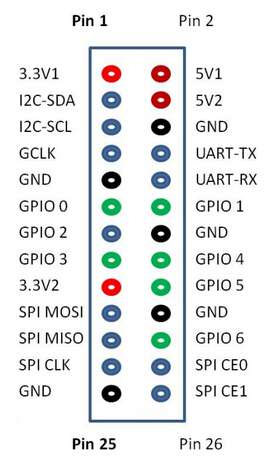
Banana Pi has no direct relationship to the Raspberry Pi Foundation, though its similarities are clear.[4] "Linux User & Developer" does not consider it a "direct clone, but a considerable evolution," whilst linux.com similarly sees it as a clone with improved performance.[5][6] The board layout is very similar to the Raspberry Pi board, though it's about 10% larger and the relative spacing of some connectors varies. Not all Raspberry Pi accessories will fit as a result.
Banana Pi M1+
|
Banana Pi single board computer | |
| Developer | Banana Pi |
|---|---|
| Type | Single-board computer |
| Release date | April 2015 |
| Operating system | Android (Android 4.2, Android 4.4),Linux (Bananian, Lubuntu, Raspbian, Debian GNU/Linux, Fedora, Arch Linux ARM, Gentoo, openSUSE), Berryboot, FreeBSD, OpenWrt |
| System-on-chip used | Allwinner A20[2] |
| CPU | ARM Cortex-A7 Dual-core (ARMv7-A) 1 GHz |
| Memory | 1 GB |
| Storage | MicroSD card & SATA 2.0 |
| Graphics | Mali-400 MP2[3] |
| Dimensions | 92 mm × 60 mm |
| Weight | 48 g |
The Banana M1+ is a credit card-sized and low-power single-board computer developed in China by the Banana Pi Team, with the intention of promoting the STEM (science, technology, engineering and mathematics) education in schools.
| Banana Pi M1+ | |
|---|---|
| CPU | A20 ARM Cortex -A7 Dual-Core |
| GPU | ARM Mali400MP2Complies with OpenGL ES 2.0/1.1 |
| Memory | 1GB DDR3 |
| Network | 10/100/1000 Ethernet 8P8C, Wi-Fi |
| Video Input | A CSI input connector allows for the connection of a designed camera module |
| Video Outputs | HDMI, CVBS, LVDS/RGB |
| Audio Outputs | 3.5mm jack and HDMI |
| Power Source | 5 volt via Micro USB (DC in only) and / or Micro USB OTG |
| USB 2.0 ports | 2(direct from Allwinner A20 chip) |
| GPIO | GPIO, UART, I2C BUS, SPI BUS, WITH TWO CHIP SELECTS, CAN bus, ADC, PWM, +3.3V, +5V, GND |
| LED | Power Key & 8P8C |
| Storage | SATA 2.0 |
| OS | Android 4.4, Android 4.2, Raspbian, Lubuntu, Open Suse, Debian |
Banana Pi M2
|
Banana Pi-M2 single board computer | |
| Developer | Banana Pi |
|---|---|
| Type | Single-board computer |
| Release date | April 2015 |
| Operating system | Android (Android 4.2, Android 4.4),Linux (Bananian, Lubuntu, Raspbian, Debian GNU/Linux, Fedora, Arch Linux ARM, Gentoo, openSUSE), Berryboot, FreeBSD, OpenWrt |
| System-on-chip used | Allwinner A31[7] |
| CPU | ARM Cortex-A7 Quad-core (ARMv7-A) 1 GHz |
| Memory | 1 GB |
| Storage | MicroSD |
| Dimensions | 92 mm × 60 mm |
| Weight | 52 g |
The Banana M2 is a credit card-sized and low-power single-board computer developed in China by the Banana Pi Team, with the intention of promoting the STEM (science, technology, engineering and mathematics) education in schools.
Banana PI M2 is the open source hardware platform, Banana PI M2 is an quad core version of Banana Pi, which is an improvement over the dual-core of the Banana Pi M1, it supports on board Wi-Fi. Banana Pi M2 series runs Android, Debian linux, Ubuntu linux, Raspberry Pi images and other images. Banana PI M2 hardware: 1Ghz ARM7 quad-core processor, 1GB DDR3 SDRAM, Banana PI with Gigabit ethernet port, It can run with Android 4.4 smoothly. The size of Banana PI M2 same as Banana pi M1, it can run games, it supports 1080P high definition video output, the GPIO is compatible with Raspberry Pi B+, and it can run the ROM Image. Note: Banana Pi M2 has no SATA port, so USB must be used to provide hardisk.
| Banana Pi M2 | |
|---|---|
| CPU | A31S ARM Cortex-A7 Quad-Core, 256K[2] B L1 cache 1MB L2 cache |
| GPU | PowerVR SGX544MP2 Comply with OpenGL ES 2.0 OpenCL 1x,DX9_3 |
| Memory | 1GB DDR3 (shared with GPU) |
| Network | 10/100/1000 Ethernet 8P8C, Wi-Fi |
| Video Input | A CSI input connector allows for the connection of a designed camera module |
| Video Outputs | HDMI, LVDS/RGB |
| Audio Outputs | 3.5mm jack and HDMI |
| Power Source | 5 volt via Micro USB(DC in Only)and /or Micro USB OTG |
| USB 2.0 ports | 4 USB PORT |
| GPIO | GPIO, UART, I2C BUS, SPI BUS, WITH TWO CHIP SELECTS, ADC, PWM, +3.3V, +5V, GND |
| LED | Power Key & 8P8C |
| OS | Android and Linux etc.OS |
Banana Pi M2+(Plus)
|
Banana Pi-M2+ single board computer | |
| Type | Single-board computer |
|---|---|
| Release date | April 2016 |
| Operating system | Android (4.2, 4.4),Linux (Bananian, Lubuntu, Raspbian, Debian GNU/Linux, Fedora, Arch Linux ARM, Gentoo, openSUSE), Berryboot, FreeBSD |
| System-on-chip used | Allwinner H3[8] |
| CPU | ARM Cortex-A7 Quad-core (ARMv7-A) 1 GHz (Cache: 256kB L1, 1MB L2) |
| Memory | 1 GB (shared with GPU) |
| Storage | MicroSD |
| Graphics | Mali 400MP2 @ 600 MHz, OpenGL ES 2.0 |
| Sound | HDMI out |
| Camera | CSI input camera module |
| Connectivity | 2× USB 2.0 (3.3V or 5V), HDMI out, 10/100/1000 Mbps Ethernet, AP6212 Wi-Fi Module |
| Power | 5 V DV via Micro USB and Micro USB OTG |
| Dimensions | 65 mm × 65 mm |
| Weight | 48 g |
Model M2+(Plus) was released in April 2016. Banana PI BPI-M2+ is the open source hardware platform,Banana PI BPI-M2+ is an quad core version of Banana Pi,it support WIFI on board. use Alliwnner H3 chip on board. and mini size only 65mm*65mm.
Banana Pi BPI-M2+ series run Android,Debian linux,Ubuntu linux, Raspberry Pi image and others image. Banana PI PBI-M2 hardware: 1Ghz ARM7 quad-core processor, 1GB DDR3 SDRAM, 8G eMMC flash on board,and SDIO wifi module on board.
Note:
- Banana Pi BPI-M2+ does not support sata port, so you need use USB for hard disk.
- Banana pi BPI-M2+ does not support LCD interface.
| Banana Pi M2+(Plus) | |
|---|---|
| CPU | H3 Quad-core Cortex-A7 H.265/HEVC 4K |
| GPU | Mali400MP2 GPU @600MHz,Supports OpenGL ES 2.0 |
| Memory | 1GB DDR3 (shared with GPU) |
| Onboard Network | 10/100/1000 Ethernet |
| Onboard WIFI | SDIO AP6212(option AP6181 AP6335) |
| Video Input | A CSI input connector Camera:1 Supports 8-bit YUV422 CMOS sensor interface,2 Supports CCIR656 protocol for NTSC and PAL,3 Supports SM pixel camera sensor ,4 Supports video capture solution up to 1080p@30fps |
| Video Outputs | Supports HDMI output with HDCP,Supports HDMI CEC, Supports HDMI 30 function,Integrated CVBS, Supports simultaneous output of HDMI and CVBS |
| Audio Outputs | HDMI |
| Power Source | DC input can supply power, but USB OTG input don’t supply power |
| USB 2.0 ports | two USB 2.0 HOST, one USB 2.0 OTG |
| GPIO | 40 Pins Header,compatible with Raspberry Pi B+ |
| LED | Power led & Status led |
| IR | IR input on board |
| OS | Android, Ubuntu, Debian, Rasberry Pi Image |
Banana Pi M2 Ultra
| Developer | Banana Pi |
|---|---|
| Type | Single-board computer |
| Release date | November 2016 |
| Operating system | Android (Android 5.1.1),Linux (Bananian, Lubuntu, Raspbian, Debian GNU/Linux, Fedora, Arch Linux ARM, Gentoo, openSUSE), Berryboot, FreeBSD, OpenWrt |
| System-on-chip used | Allwinner R40[9] |
| CPU | ARM Cortex-A7 Octa-core (ARMv7-A) 2 GHz |
| Memory | 2 GB |
| Storage | MicroSD card & 8GB eMMC & support SATA interface |
| Graphics | Mali400 MP2 |
| Dimensions | 92 mm × 60 mm |
| Weight | 45 g |
Banana PI BPI-M2 Ultra is the open source hardware platform, Banana PI BPI-M2 Ultra is a quad-core cortex -A7 CPU ,use Allwinner R40 design, it support WIFI+BT on board.and support SATA interface on board. Banana PI PBI-M2 Ultra hardware: Quad Core ARM Cortex A7,ARMv7 CPU, 2GB DDR3 SDRAM, 8G eMMC flash on board.
Banana PI BPI-M2 Ultra with Gigabit Ethernet port, It can run Android smoothly. The size of Banana PI BPI-M2 Ultra same as Banana Pi BPI-M64, support 1080P video, the 40 pin GPIO header is pin-compatible with Raspberry Pi.
Note:
- support SATA interface
- if you use 3.5 big hardisk ,you may need power with outside power. on board power can not support enough current
| Banana Pi M2 Ultra | |
|---|---|
| CPU | quad-core cortex -A7,the most power efficient CPU core ARM's ever development |
| GPU | dual-core MALI-400 MP2 and runs at 500MHz, capable of 1.1 Gpixel/s throughput. Graphics capabilities are slightly higher than the original Xbox’s level of performance. The GPU provides OpenGL ES 2.0, hardware-accelerated OpenVG, 1080p45 H.264 high-profile encode and decode. |
| Memory | 2GB LPDDR3 (shared with GPU) |
| Storage | On Board 8GB eMMC Flash, Micro SD-Card slot, suppoort SATA interface |
| Network | 10/100/1000 Mbit/s Ethernet (Realtek RTL8211E/D) + Wi-Fi 802.11 b/g/n (AP6212) + Bluetooth BT4.0 |
| Video Input(s) | A CSI input connector allows for the connection of a designed camera module |
| Video Output(s) | HDMI 1.4 (Type A Full), MIPI Display Serial Interface (DSI) for raw LCD Panel |
| On board Storage | MicroSD (TF) card, eMMC 8G on board (option:16/32/64G) |
| Audio Input(s) | On board microphone |
| Audio Output(s) | 3.5mm jack and HDMI |
| USB ports | USB 2.0 PORT (x2), USB OTG (x1) |
| Remote | IR Receiver (x1) |
| GPIO | 40 Pin Header : GPIO (x28) and Power (+5V, +3.3V and GND). Some of I/O Pin can be used for specific functions as UART, I2C, SPI or PWM |
| Switches | Reset, Power and U-boot |
| LED | Power status Led and RJ45 Led |
| Power Source | 5 volt @2A via DC Power and/or Micro USB (OTG) |
| Size & Weight | 92x60mm, 45g |
| OS | Android and Linux |
Banana Pi M3
|
Banana Pi-M3 single board computer | |
| Developer | Banana Pi |
|---|---|
| Type | Single-board computer |
| Release date | November 2015 |
| Operating system | Android (Android 5.1.1),Linux (Bananian, Lubuntu, Raspbian, Debian GNU/Linux, Fedora, Arch Linux ARM, Gentoo, openSUSE), Berryboot, FreeBSD, OpenWrt |
| System-on-chip used | Allwinner A83t[10] |
| CPU | ARM Cortex-A7 Octa-core (ARMv7-A) 2 GHz |
| Memory | 2 GB |
| Storage | MicroSD card & 8GB eMMC & SATA 2.0[11] |
| Graphics | Power VR SGX544MP1 |
| Dimensions | 92 mm × 60 mm |
| Weight | 48 g |
Banana Pi M3 is an open source hardware platform. Banana Pi M3 is an octa-core version of Banana Pi, it supports onboard Wi-Fi and SATA Port. Banana Pi M3 runs Android 5.1.1, Debian linux, Ubuntu linux, Raspberry Pi images and other images. Banana PI M3 hardware: 2Ghz ARM7 octa-core processor, 2GB LPDDR3 SDRAM, gigabit ethernet port and the GPIO is compatible with Raspberry Pi B+. The size of Banana Pi M3 is the same as Banana Pi M1.
| Banana Pi M3 | |
|---|---|
| CPU | Allwinner A83T ARM Cortex-A7 Octa-Core 1.8 GHz, 512KB L1 cache and 1MB L2 cache |
| GPU | PowerVR SGX544MP1 Comply with OpenGL ES 2.0 OpenCL 1x, DX9_3 |
| Memory | 2GB LPDDR3 (shared with GPU) |
| Storage | On Board 8GB eMMC Flash, Micro SD-Card slot, SATA 2.0 Port (USB-to-SATA bridge)[11] |
| Network | 10/100/1000 Mbit/s Ethernet (Realtek RTL8211E/D) + Wi-Fi 802.11 b/g/n (AP6212) + Bluetooth BT4.0 |
| Video Input(s) | A CSI input connector allows for the connection of a designed camera module |
| Video Output(s) | HDMI 1.4 (Type A Full), MIPI Display Serial Interface (DSI) for raw LCD Panel |
| Audio Input(s) | On board microphone |
| Audio Output(s) | 3.5mm jack and HDMI |
| USB ports | USB 2.0 PORT (x2), USB OTG (x1) |
| Remote | IR Receiver (x1) |
| GPIO | 40 Pin Header : GPIO (x28) and Power (+5V, +3.3V and GND). Some of I/O Pin can be used for specific functions as UART, I2C, SPI or PWM |
| Switches | Reset, Power and U-boot |
| LED | Power Status and 8P8C |
| Power Source | 5 volt @2A via DC Power and/or Micro USB (OTG) |
| Size & Weight | 92x60mm, 48g |
| OS | Android and Linux |
Banana Pi M64
|
Banana Pi-M64 single board computer | |
| Type | Single-board computer |
|---|---|
| Release date | November 2016 |
| Operating system | Android (Android 5.1.1),Linux (Bananian, Lubuntu, Raspbian, Debian GNU/Linux, Fedora, Arch Linux ARM, Gentoo, openSUSE), Berryboot, FreeBSD |
| System-on-chip used | Allwinner A64t[12] |
| CPU | ARM Quad-core Cortex-A53 Octa-core (ARMv7-A) 1.2 GHz |
| Memory | 2 GB |
| Storage | MicroSD card & 8GB eMMC |
| Graphics | Mali400MP2 GPU |
| Dimensions | 92 mm × 60 mm |
| Weight | 48 g |
Banana PI BPI-M64 is the open source hardware platform, Banana PI BPI-M64 is a quad-core 64 bit version of Banana Pi,use Allwinner A64 design, it support Wi-Fi and Bluetooth on board.
Banana Pi BPI-M64 series run Android, Debian linux, Ubuntu linux,Raspbian image and other OS.
Banana PI PBI-M64 hardware: 64 Bit Quad Core ARM Cortex A53 1.2 GHz CPU, 2GB DDR3 SDRAM, 8G eMMC flash on board
Banana PI BPI-M64 with Gigabit Ethernet port, It can run Android smoothly. The size of Banana PI BPI-M64 same as Banana Pi BPI-M3, support 1080P 4K video, the GPIO header is pin-compatible with Raspberry Pi.
The new BPI-M64 is a tiny little computer with great big ambitions. The expandable single-board device runs either Linux or Android and features impressive specs that outshine comparable products by a substantial margin. Highlights include a 1.2 GHz quad-core ARM processor, a Mali 400 MP2 GPU, 2G of DDR3 RAM, a microSDXC slot,8G eMMC flash, Wi-Fi & BT on-board and support for 4K ultra high-definition video.
| Banana Pi M64 | |
|---|---|
| CPU | Allwinner 64 Bit Quad Core ARM Cortex A53 1.2 GHz CPU |
| GPU | Dual core Mali 400 MP2 GPU |
| Memory | 2GB LPDDR3 (shared with GPU) |
| Storage | MicroSD slot supports up to 256GB expansion & 8G eMMC flash (option 16/32/64G) |
| Network | 10/100/1000 Mbit/s Ethernet + Wi-Fi 802.11 b/g/n + Bluetooth BT4.0 |
| Video Input(s) | A CSI input connector allows for the connection of a designed camera module |
| Video Output(s) | 4K high-definition video playback & 4K x 2K HDMI port and multi-channel audio output |
| Audio Input(s) | On board microphone |
| Audio Output(s) | 3.5mm jack and HDMI |
| USB ports | USB 2.0 PORT (x2), USB OTG (x1) |
| Remote | IR Receiver (x1) |
| GPIO | 40 Pin Header : GPIO (x28) and Power (+5V, +3.3V and GND). Some of I/O Pin can be used for specific functions as UART, I2C, SPI or PWM |
| Switches | Reset, Power and U-boot |
| LED | Power Status and 8P8C |
| Power Source | 5 volt @2A via DC Power and/or Micro USB (OTG) |
| Size & Weight | 92x60mm, 48g |
| OS | Android and Linux |
Banana Pi G1
Banana Pi-G1 is an integrated IEEE802.11 b/g/n (Wi-Fi wireless network), IEEE802.15.4 (Zigbee), IEEE 802.11-2007 Standard (Bluetooth Low Energy 4.0) development board. All three wireless protocols can be used together, you can exchange any different transport protocols, and each wireless protocol is supported by its own single-chip SOC, which can facilitate Internet of Things (IoT) projects.
The Wi-Fi uses TI CC3200, which is a high-performance ARM Cortex-M4 wireless SOC, internally integrated TCP/IP protocol stack. This allows simple connection to the Internet using the BSD Socket.
The Zigbee uses TI CC2530, which integrates wireless capabilities and enhanced 8051 core SOC. After years of improvement, it is quite mature and stable. TI's Z-stack has achieved Zigbee 2007/Pro, you can use the 16's short address, you can use the 64-bit long address communication, face large local interconnect systems, providing advanced security encryption and mesh network structure support.
The Bluetooth 4.0 (BLE) uses TI CC2540/1, an integrated BLE stack and enhanced 8051 core, low-power wireless SOC. At present, most mobile phones have support for Bluetooth 4.0, both as a wearable device, or mobile interactive accessories, CC2540 can be easily completed. Meanwhile, BPI G1 also incorporates a high-performance STM32 ARM Cortex-M3 microcontroller, which help in dealing with time-consuming data or transit, the three wireless SOC coordinated.
Therefore, the Banana Pi G1 support a wide range of Internet of Things DIY wireless projects.
|
Banana Pi single board computer | |
| Developer | Banana Pi |
|---|---|
| Type | Single-board computer |
| Release date | April 2015 |
| Operating system | Free-RTOS,TI-OS、Coutom-OS |
| System-on-chip used | STM32F103 |
| Dimensions | 95 mm × 56 mm |
| Weight | 19 g |
| Banana Pi G1 | |
|---|---|
| MCU | STM32F103CB ARM Cortex™ -M3 32-bit RISC core |
| Wi-Fi | TI CC3200 integrated ARM Cortex-M4 MCU with Wi-Fi network cc 3200 device is an integrated high-performance ARM Cortex-M4 MCU and with a Wi-Fi network processor subsystem (This subsystem includes 802.11 b/g/n radio, baseband, network protocol stack, a powerful encryption engine MAC, supports 256 bit encryption in order to achieve a fast, secure Internet connection). This device contains a variety of peripherals, including a fast parallel camera interface, I2S, SD/MMC, UART, SPI, I2C, and four-channel analog to digital converter (ADC). |
| Bluetooth | TI CC2540 device is a low cost,low power, true system-on-chip(SoC) for Bluetooth low energy applications. It enables to build a strong BLE master or slave node with low total BOM cost. |
| ZigBee | IEEE802.15.4 via TI CC2530 (SoC)for IEEE 802.15.4, Zigbee RF4CE applications and solutions. CC2530 combines an excellent RF transceiver, industry-standard enhanced 8051 MCU, in-system programmable flash memory, 8 KB RAM, outstanding performance, and many other powerful features. |
| Power Source | 5V DC |
| Buttons | reset |
| LED | Wi-Fi Bluetooth ZigBee |
| Display | OLED(128*64) |
| OS | Free-RTOS Ti-OS Custom-OS |
Powered by AXP209 power management unit, Banana Pi is able to output up to 1.6A, which means users can drive an external HDD without an extra power supply.
The Banana Pi board is similar to Cubieboard2.[13]
|
Banana Pi single board computer | |
| Developer | Banana Pi |
|---|---|
| Type | Single-board computer |
| Release date | October 2014 |
| Operating system | running on Linux 3.4.35 |
| CPU | ARM986EJ 32Bits RISC Core 400 MHz |
| Memory | 64MB DDR2 |
| Storage | MicroSD card |
| Dimensions | 38 mm × 38 mm |
| Weight | 10 g |
|
Banana Pi single board computer | |
| Developer | Banana Pi |
|---|---|
| Type | Single-board computer |
| Release date | October 2014 |
| Operating system | Android (Android 4.2, Android 4.4),Linux (Bananian, Lubuntu, Raspbian, Debian GNU/Linux, Fedora, Arch Linux ARM, Gentoo, openSUSE), Berryboot, FreeBSD, OpenWrt |
| System-on-chip used | Allwinner A20[2] |
| CPU | ARM Cortex-A7 Dual-core (ARMv7-A) 1 GHz |
| Memory | 1 GB |
| Storage | MicroSD card & SATA 2.0 |
| Graphics | Mali-400 MP2[3] |
Banana Pi-D1
The BPI-D1 is one of the smallest open-source development boards currently on the market, with a built-in HD mini camera. At 36mm (w) x36mm (l) and weighing in at 10g, it is claimed to be much smaller than other boards with comparable features. The board is specially suited to mini-cam applications, providing high-resolution image quality: both video and still capture at 1280x720p with a video capture rate of 30 fps.
The Banana Pi-D1 is designed to provide a set of multimedia tools in one small package, that can be run from an external battery source.
The major features of the D1 include: HD mini-cam, audio sensor, microphone, CPU, GPIO, and Wi-Fi,
Banana Pi R1
 | |
|
Banana Pi single board computer | |
| Developer | Banana Pi |
|---|---|
| Type | Single-board computer |
| Release date | October 2014 |
| Operating system | Android (Android 4.2, Android 4.4),Linux (Bananian, Lubuntu, Raspbian, Debian GNU/Linux, Fedora, Arch Linux ARM, Gentoo, openSUSE), Berryboot, FreeBSD, OpenWrt |
| System-on-chip used | Allwinner A20[2] |
| CPU | ARM Cortex-A7 Dual-core (ARMv7-A) 1 GHz |
| Memory | 1 GB |
| Storage | MicroSD card & SATA 2.0 |
| Graphics | Mali-400 MP2[3] |
| Dimensions | 92 mm × 60 mm |
| Weight | 48 g |
The Banana Pi R1 is a 300Mbit/s Wireless N Router with both wired and wireless network connections is designed specifically for smart home networking use. With 2T2R MIMO technology and two detachable antennas, the R1 is a dual core system that runs smoothly with Android 4.2.2 and has a Gigabit ethernet port, SATA socket, supports games and 1080P high definition video output.
-

BPI-R1
-

BPI-R1
Banana Pi Pro
The Banana Pi Pro is a credit card-sized and low-power single-board computer developed in China by the LeMaker Team, with the goal of promoting STEM (science, technology, engineering and mathematics) education in schools.
Like its smaller sibling the Banana Pi, the Pro concept is heavily influenced by the Raspberry Pi, however the Banana Pro provides various enhancements over prior designs.
The Banana Pro has an Allwinner A20 system on a chip (SoC), which includes an ARM Cortex-A7 Dual-core (ARMv7-A) 1 GHz, Mali-400 MP2 GPU and 1GB DDR3 SDRAM.
The Banana Pro uses a microSD card for booting an OS, but also includes a SATA 2.0 interface to allow connection of a hard disk for additional storage, however you cannot boot from the hard disk.
Other differences from the Banana Pi include on-board Wi-Fi 802.11 b/g/n AP6181, integrated composite video and audio output into a 3.5 mm TRRS jack. This makes space for a 40-pin extension header.
Specifications
| Banana Pi[14] | Banana Pro[15] | |
|---|---|---|
| SoC | Allwinner A20 | Allwinner A20 (CPU, GPU, SATA 2.0, 3 USB ports) |
| CPU | 1 GHz ARM Cortex-A7 Dual-core | 1 GHz ARM Cortex-A7 Dual-core (ARMv7 instruction set) |
| GPU | ARM Mali-400 MP2 dual GPU core | Mali-400 MP2 - complies with OpenGL ES 2.0/1.1 (hardware acceleration support) |
| Memory (SDRAM) | 1 GB DDR3 DRAM (shared with GPU) | 1 GB DDR3 DRAM (shared with GPU) |
| Power | Expects 5 V source connected to the micro-USB connector, recommended 2 A if connecting a SATA hard disk using the onboard power connector | 5 V @ 2 A via micro-USB (DC in only) and/or micro-USB (OTG) |
| PMU | AXP209 | |
| USB | 2 USB 2.0 host, 1 USB OTG | 2 USB 2.0 host, 1 USB 2.0 OTG (all direct from A20 chip) |
| Low-level peripherals | 26 extended pins including I²C, SPI, UART, CAN bus | 40 pins GPIO headers
28 GPIO, some of which can be used for specific functions including UART, I2C, SPI, PWM, CAN, I2S, SPDIF |
| Onboard Storage | SD slot (maximum 64 GB), 7-pin SATA 2.0 data port (with a separate power connector), supporting maximum 4 TB hard drive | MicroSD card
SATA 2.0 (with a separate power connector) |
| Onboard Network | 10/100/1000 Ethernet connector, with LEDs | 10/100/1000 Ethernet 8P8C,
65 Mbit/s Wi-Fi 802.11 b/g/n AP6212 |
| Bluetooth | Optional | |
| Display | Allwinner A20 built-in, supports HDMI 1080p and CVBS | Supports multi-channel HD display:
HDMI 1.4 (Type A - full), composite video (PAL and NTSC) (via 3.5 mm TRRS jack shared with audio out), LVDS/RGB/CPU display interface (DSI) for raw LCD panels. 11 HDMI resolutions from 640×480 to 1920×1080 plus various PAL and NTSC standards |
| Video | CedarX | HD H.264 2160p video decoding. Multi-format FHD video decoding, including MPEG1/2, MPEG4, H.263, H.264, etc. H.264 high-profile 1080p@30fps or 720p@60fps encoding |
| Camera | 1 CSI camera connector | Parallel 8-bit camera interface |
| Audio Outputs | ⌀3.5 mm audio output jack | HDMI, analog audio (via 3.5 mm TRRS jack shared with composite video out), I2S audio (also potentially for audio input) |
| Audio input | Onboard microphone | Onboard microphone |
| Buttons | Power, reset and u-boot switches mounted on board | Power, reset and u-boot switches mounted on board |
| LEDs | One user-defined LED on board | Power status LED (red), Ethernet status LED (blue), user defined LED (green) |
| Other | Onboard IR receiver | Onboard IR receiver |
| Dimensions | 92 mm × 60 mm | 92 mm × 60 mm |
| Weight | 48 g | 48 g |
Available operating systems
Banana Pi[15]
- Android 4.2.2 & 4.4 for Banana Pi (Linux kernel 3.4.39+, 4.4 doesn't support Wi-Fi and has many bugs, 4.2.2 doesn't support all apps in Korea)
- Archlinux for Banana Pi (Linux kernel 3.4.103; 2014-12-26)
- Bananian Linux (Debian based; Linux kernel 3.4.111; 2016-04-23)
- CentOS 7 (1511)
- Debian for Banana Pi (Linux kernel 3.4.107 & mainline; 2015-01-16)
- Fedora for Banana Pi (Linux kernel 3.4.103; 2014-12-26)
- Kali Linux for Banana Pi (Linux kernel 3.4.103)
- Kano for Banana Pi (Linux kernel 3.4.103)
- Lubuntu for Banana Pi (Linux kernel 3.4.103; 2014-12-26)
- NetBSD 7.0
- nOS for Banana Pi (Linux kernel 3.4.103)
- openSUSE for Banana Pi (openSUSE v1412; Linux kernel 3.4.103; 2014-12-26)
- Raspbian for Banana Pi (Linux kernel 3.4.103; 2014-12-26)
- ROKOS for Banana Pi (Linux kernel 3.4.103; 2014-12-26)
- Scratch for Banana Pi (Boot to Scratch directly) (Linux kernel 3.4.103)
See also
References
- ↑ "Debian Wiki: armhf – Arm Hard Float Port". Debian Wiki.
- 1 2 3 4 "A20_Allwinner Technology". Allwinnertech.com. 2013-04-23. Retrieved 2016-07-12.
- 1 2 3 4 "Mali-400". ARM. Retrieved 2016-07-12.
- ↑ Heath, Nick (21 May 2014). "Raspberry Pi: Five alternatives for hackers and modders". TechRepublic.
- ↑ Halfacree, Gareth. "Banana Pi review – tastier than Raspberry?". Linux User & Developer.
- ↑ Brown, Eric (24 April 2014). "Raspberry Pi Clones Match the Connectors, But Boost the Firepower". Linux News.
- ↑ "A31_Allwinner Technology". Allwinnertech.com. 2013-04-23. Retrieved 2016-07-12.
- ↑ "H3_Allwinner Technology". Allwinnertech.com. 2013-04-23. Retrieved 2016-07-12.
- ↑ "R40_Allwinner Technology". Allwinnertech.com. 2016-01-01. Retrieved 2016-10-27.
- ↑ "A80_Allwinner Technology". Allwinnertech.com. 2013-04-23. Retrieved 2016-07-12.
- 1 2 forum.banana-pi.org The M3 has no SATA support, its USB-to-SATA bridge is many times slower than the native SATA implementation of M1/M1+
- ↑ "A64_Allwinner Technology". Allwinnertech.com. 2015-08-14. Retrieved 2016-07-12.
- ↑ "Test: Einplatinen-Computer Banana Pi als Raspberry-Pi-Ersatz". CT Magazine (in German).
- ↑ "Banana Pi Specifications". Lemaker Wiki.
- 1 2 "Specifications from board manufacturer". Banana Pro.
